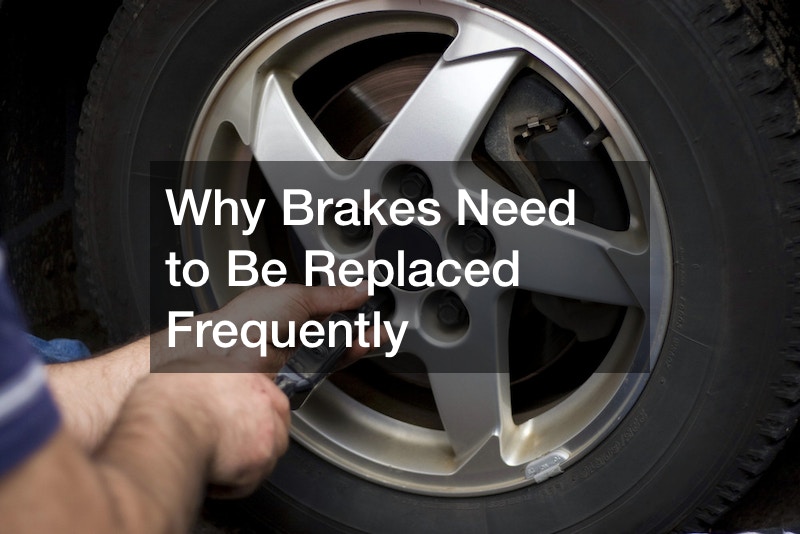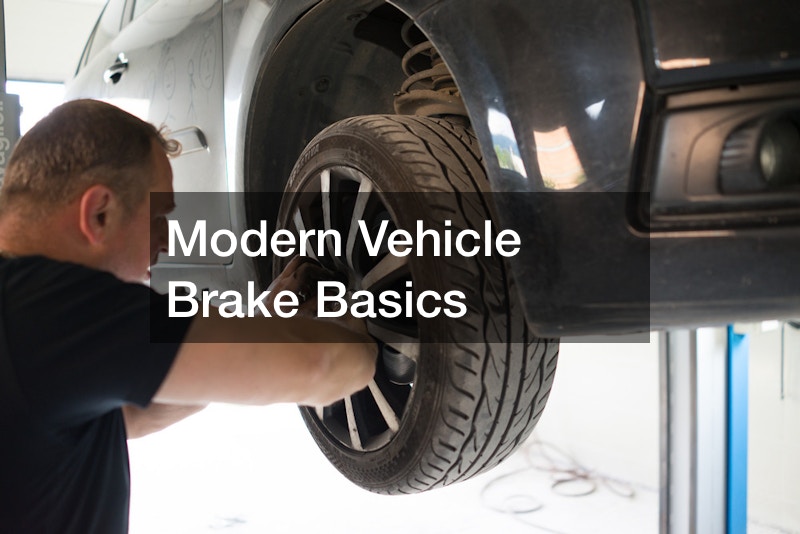Anyone who has driven a car knows just how important the brakes are. They are essential to stopping the vehicle when you press the brake pedal. Just like most parts of a car, they require some care and attention. This article gives you some basic information about brakes.
All Vehicles Need Brakes
When it comes to vehicle brake basics, the fundamental purpose of brakes is to stop or slow down a vehicle. They are an essential safety feature in vehicles. Brakes provide drivers with control of their speed and how they stop. Brakes prevent accidents and keep drivers, passengers, and other road users safe. Brakes work because they convert kinetic energy from the moving vehicle into heat energy through friction.
As you press the brake pedal, it applies hydraulic pressure to the brake calipers. The calipers then clamp down on the brake rotors to slow down or stop the spinning wheels. This friction between the brake pads and the rotors slows down the vehicle and eventually stops it. If you didn’t have brakes in your vehicle, it would be difficult to stop, and there would be many more accidents.
All vehicles have brakes, including golf carts. Even though golf carts are smaller vehicles, they still need to stop when in motion. Therefore, they are mainly used on golf carts or in areas that have golf carts. The brakes in a golf cart work basically the same way as vehicles in a traditional vehicle. Therefore, like brakes on other vehicles, you may need golf cart repairs on your brakes.
Brakes Don’t Last Forever
When learning about vehicle brake basics, you probably understand that your brakes won’t last forever. They will need to be replaced. It is helpful to have an understanding of how much your brakes will cost to repair. There is repair estimate software that is intended to help automotive repair shops and brake technicians when assessing the status of brakes. This type of software helps technicians accurately estimate the cost of brake repairs.
This software product is used to estimate the cost of parts, labor, and any other associated costs. This makes it easy for repair shops to provide their customers with a detailed and accurate estimate of the cost of the brake repair. You can find unique features in this software, including the creation of custom quotes, tracking parts and labor costs, and integration with other automotive software systems. These applications provide technical information to technicians that help them repair procedures, which makes it easier for them to diagnose and repair brake problems. Repair shops and brake technicians can choose the software that best meets their needs based on factors such as cost, functionality, and ease of use.

Why Brakes Need to Be Replaced Frequently
When thinking about vehicle brake basics, it is essential to know how often your brakes may need to be replaced. This could be critical when looking at used trucks for sale. If you have an idea of how long brakes will last, it may be helpful when making a decision about buying the vehicle. The brake pads and rotors wear down over time because they make contact and cause friction.
The friction generates heat and wears away the brake pads and rotors. The heat and wear and tear lead to decreased braking performance and safety concerns. As a result, regular replacement of brake components is necessary to maintain the vehicle’s braking ability. This also helps maintain the overall safety of the driver and passengers. How often you replace your brakes depends on various factors, including driving habits, vehicle weight, and road conditions. The make and model of the vehicle can also make a difference in how often brakes need a replacement.
There is a general expectation of how often brakes should be replaced. For example, you can expect brake pads to need a replacement every 25,000 to 70,000 miles. Brake rotors may need to be replaced every 50,000 to 70,000 miles.
How to Tell When Brakes Are Due for Replacement
One of the valuable vehicle brake basics information you should know is how to tell when brakes need to be replaced. This can be helpful when looking for repairable salvage SUVs for sale. When you know what to look for and listen for with brakes can be helpful when making decisions about brakes. For example, if you hear a squeaking or grinding noise when applying the brakes, you should consider replacing them. When the brakes are going, you may feel that the brake pedal is soft and spongy. You may also notice that you can press the brake pedal low to the floor.
When the brakes start to fail, you may find that you need longer stopping distances or reduced braking performance. When there are pulsations or vibrations in your steering wheel or brake pedal when braking, you should have your brakes checked. You may also feel the car pulling to one side while braking, which might indicate that there is a problem with the brakes. There are warning lights on the dashboard that may come on when there is a problem with your brakes. When you have regular brake inspections, maintenance can help prevent potential future safety issues and costly repairs.

The Parts of Your Vehicle’s Brake System
There are many vehicle brake basics that you should know. One of the items you should understand is the different parts of a brake system. The brake pedal is a lever on the floor of your car that is operated by your foot. When you apply force to the lever, it applies the brakes. The brake booster is a device used to amplify the force you apply to the brake pedal. When you are looking at aftermarket auto parts, you should know all the differences with the brakes.
The master cylinder is a device that is piston operated and works to convert the force from the brake pedal into hydraulic pressure. This is the part that causes the brakes to operate. Another part is the brake lines, which are rubber or metal tubes that transfer the brake fluid to the master cylinder, brake calipers, and wheel cylinders. The brake calipers clamp the brake pads onto the brake rotors. They work to slow down the vehicle.
The brake rotors are metal discs that rotate with the wheels. They work to provide the surface for the brake pads to grip and slow the vehicle. Brake pads create friction against the brake rotors to slow the vehicle down. The wheel cylinders are hydraulic cylinders that actuate the brake shoes in drum brakes.
Different Modern Vehicle Brakes for Different Vehicles
When thinking about vehicle brake basics, it is critical to understand that brakes can be different in different vehicles. The brakes for a vehicle depend on the weight and intended use. For example, smaller cars often have disc brakes on all four wheels, but large trucks might use drum brakes on the rear wheels. In addition, high-performance sports cars may use specialized brakes that have larger rotors or multiple calipers to provide greater stopping power.
Disc brakes are a type of braking system often used in vehicles, bicycles, and other machinery. They use a flat, circular metal disc, known as a rotor, that is attached to the wheel. When the brake pedal is pressed, hydraulic pressure is used to force the brake calipers onto the rotor. This process creates friction, which slows down and eventually stops the wheel from turning. Disc brakes are generally more effective and durable than other types of brakes. As a result, they are the most common type you find in auto body shops.

Vehicle Size Matters
One of the top vehicle brake basics to know is that the size of your vehicle directly impacts the brakes needed to stop it. Larger vehicles require different types of brakes. If you are interested in trucking jobs, you should understand the braking system in larger vehicles. Trucks and buses typically require larger and more powerful braking systems because of their heavier weight and larger size.
For example, some heavy-duty trucks may use air brakes. Air brakes use compressed air to apply the brakes instead of hydraulic pressure. Similarly, high-performance sports cars may use larger disc brakes with multiple calipers to provide greater stopping power. The faster a car can move also means the faster it needs to be able to stop. In addition to size and weight, the intended use and performance requirements of a car determine its brake needs.
Do Clutch and Brake Systems Interact?
While this topic may not typically fall under common vehicle brake basics, it is important to understand how the clutch and brake systems interact. There are certain situations when they interact with each other. To use your car properly, you should have a basic understanding of those times. When you drive a manual transmission, it is best if you have a solid understanding of these two systems. This information may help you determine when you need truck clutch service.
As you downshift to a lower gear, you may need to use both the clutch and brake pedals at the same time to smoothly and safely slow down. When you are coming to a complete stop, you must depress the clutch pedal to disengage the engine from the transmission while simultaneously applying the brake pedal to bring the vehicle to a stop.
The clutch and brake systems are also connected hydraulically in some vehicles. This means that the vehicle is using the same hydraulic fluid to operate both the clutch and brake systems. However, most often, you will find that the clutch and brake systems are separate and independent, each serving its specific purpose in vehicle control and safety.

Brake Safety Basics
One significant component of vehicle brake basics is understanding how to keep them working properly and ensure they are safe. It would be best if you were sure to inspect or have your vehicle inspected on a regular basis. This inspection should include the brakes to verify that they are functioning properly. An inspection includes checking for worn brake pads and leaks in the brake lines and ensuring that the brake fluid is at the correct level. You should be aware that brake pads should be replaced as needed to ensure that they have enough material to stop the vehicle safely. When you have worn brake pads, they can cause decreased stopping power and require longer stopping distances.
Your brake fluid should be flushed periodically to remove contaminants and moisture. These elements can negatively impact the brake system’s performance. When applying your brakes, the pedal should feel firm and consistent. If they are soft or spongy, it may indicate air in the brake lines or a problem with the master cylinder. When thinking about your brakes and fuel tanks, you should be aware there are several safety features designed to prevent any interaction between the brake and fuel systems. However, if you notice any unusual smells or leaks around the brake or fuel system, have it inspected immediately.
What About Engine Brakes?
When considering vehicle brake basics, you don’t want to forget about engine brakes. Engine brakes are often called compression brakes or Jake brakes. This type of system is used in diesel engines. Engine brakes work to change the engine’s operation to convert it into a power-absorbing device. When the brake pedal is released, the engine brake opens the exhaust valves to create resistance to the engine’s rotation. This resistance is what slows down the vehicle, so it doesn’t rely solely on the traditional braking system. These brakes are noisy and are the cause of the popping sound when a vehicle like a bus brakes. Crankshaft machining may be needed for this process to work properly.
This article gives you a great foundation of all the information you should know when it comes to your braking system. This can help you understand when to inspect your brakes to keep you and others safe on the road.
